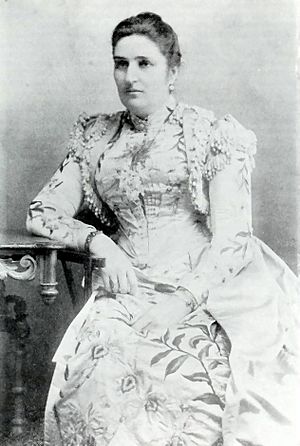Edith Blake facts for kids
Quick facts for kids
Lady Blake
|
|
|---|---|

Edith Blake
|
|
| Spouse of the Governor of Hong Kong | |
| In office 25 November 1898 – 21 November 1903 |
|
| Governor | Sir Henry Arthur Blake |
| Preceded by | Felicia Robinson |
| Succeeded by | Flora Shaw, Lady Lugard |
| Personal details | |
| Born |
Edith Bernal Osborne
7 February 1846 Newtown Anner House, Clonmel, Ireland |
| Died | 18 April 1926 (aged 80) Myrtle Grove, Youghal, Ireland |
| Resting place | Myrtle Grove, Youghal |
| Nationality | Irish |
| Known for | botanical illustration |
|
Notable work
|
studies of Jamaican lepidoptera |
| Spouse(s) |
Henry Arthur Blake
(m. 1874; died 1918) |
| Children | 3 |
| Parent(s) | Ralph Bernal Osborne Catherine Isabella Osborne |
| Relatives | Fanny Currey, Gwen Richardson |
Edith Bernal, Lady Blake (born Osborne; 7 February 1846 – 18 April 1926) was an Irish artist and writer. She was especially known for her detailed drawings of plants and animals. She studied nature in places like The Bahamas, Jamaica, and Sri Lanka.
Contents
Early Life and Family
Edith Blake was born on 7 February 1846. Her family home was Newtown Anner House, near Clonmel, Ireland. She was the oldest daughter of Catherine Isabella Osborne and Ralph Bernal Osborne. Her father took his wife's last name after they married.
Edith and her sister Grace were mostly raised by their mother. Her mother was a talented artist and encouraged her daughters to be creative. Many artists visited their home, and Edith might have learned from them. She became very interested in plants and wrote to Joseph Paxton, who designed the gardens at Newtown Anner. She also worked with her friend Fanny Currey on art projects.
In 1874, Edith married Henry Arthur Blake. Her parents did not approve of the marriage. They wanted her to marry someone else. So, Edith and Henry ran away to get married without her parents' permission. Because of this, Edith's parents decided not to leave her any money or property.
The couple had two sons and one daughter. Henry worked as a police officer and later as a special judge during a time of land disputes in Ireland. When his life was threatened, Edith would travel with him and carry a gun to protect them. Even though her husband worked for the government, Edith understood and supported Irish national feelings. She became friends with Anna Parnell, a well-known Irish activist.
Travels and Art Work
In 1872, Edith traveled around Europe. She visited many countries, including Austria, Italy, and Greece. She drew pictures of the buildings, art, and culture she saw. She later published these drawings in her first book, Twelve Months in Southern Europe (1876). She also wrote another book called The Realities of Freemasonry in 1879.
Edith's husband, Henry, became a governor in different parts of the British Empire. He served in The Bahamas (1884–1887), Newfoundland (1887–1888), Jamaica (1889–1897), Hong Kong (1898–1903), and Sri Lanka (1903–1907). Edith traveled with him to all these places.
Instead of just attending social events, Edith spent her time studying nature. She painted local plants and animals using watercolors. She painted them directly from nature. Her paintings were shown at the Museum of Science and Art in Dublin in 1894.
Many of her detailed studies of Jamaican butterflies and moths (called lepidoptera) are now kept at the Natural History Museum in London. More of her work is at the National Botanic Gardens in Dublin. People say that while she was in The Bahamas, she was even painted with a pet snake wrapped around her waist!
Edith also painted landscapes and important events, like the opening of the Newfoundland Placentia Railway in 1888. She wrote articles for science magazines in England and America. She was very involved in helping the countries where she lived. For example, she collected over 100 Native American artifacts from The Bahamas. This collection is now at the National Museum of the Native American in New York.
Edith was also very good at languages. She could speak nine languages, including Irish, Russian, and Chinese. In 1907, she helped open a Buddhist nunnery in Sri Lanka, which was named after her.
Later Life
When Henry retired in 1907, the Blakes moved back to Ireland. They settled at Myrtle Grove in County Cork. Many of Edith's sketchbooks are still kept there. She even decorated the staircase with her beautiful plant drawings.
As Lady Blake, she wrote three plays based on old Irish stories: Samhain's Eve, The Quest of Edain, and The Swan.
After her husband died in 1918, Edith lived a quiet life. She continued to paint until she passed away at Myrtle Grove on 18 April 1926. She and her husband are buried in the garden of their home.
Her collection at the Natural History Museum in London was carefully preserved in 1984. It is still valued for its scientific importance today.
Selected Publications
Non-fiction
- Twelve Months in Southern Europe. London, 1876.
- The Realities of Freemasonry. Chapman and Hall, London, 1879.
- "The Maroons of Jamaica" in The North American Review, Vol. 167 (1898), pp. 558-568.
Plays
- Samhain's Eve
- The Quest of Edain
- The Swan
See also
 In Spanish: Edith Blake para niños
In Spanish: Edith Blake para niños

